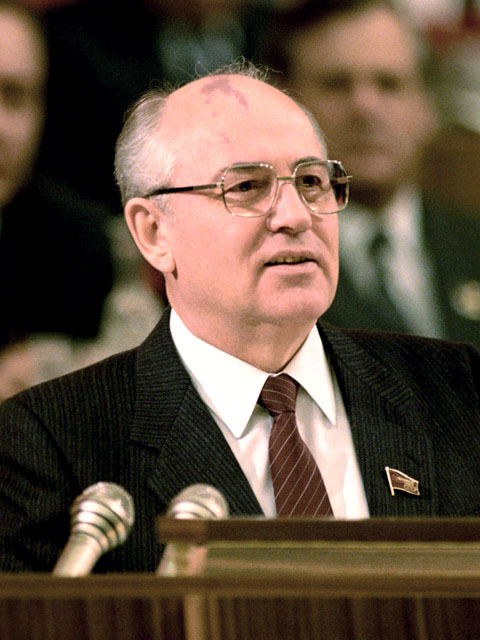
FROM WIKIPEDIA COMMONS
Mikhail Sergeyevich Gorbachev[f] (2 March 1931 – 30 August 2022) was a Russian and Soviet politician who served as the last leader of the Soviet Union from 1985 to the country’s dissolution in 1991. He served as General Secretary of the Communist Party of the Soviet Union from 1985 and additionally as head of state beginning in 1988, as Chairman of the Presidium of the Supreme Soviet from 1988 to 1989, Chairman of the Supreme Soviet from 1989 to 1990 and the only President of the Soviet Union from 1990 to 1991. Ideologically, Gorbachev initially adhered to Marxism–Leninism but moved towards social democracy by the early 1990s.
Gorbachev was born in Privolnoye, Stavropol Krai, to a poor peasant family of Russian and Ukrainian heritage. Growing up under the rule of Joseph Stalin, in his youth he operated combine harvesters on a collective farm before joining the Communist Party, which then governed the Soviet Union as a one-party state according to the prevailing interpretation of Marxist–Leninist doctrine. Studying at Moscow State University, he married fellow student Raisa Titarenko in 1953 and received his law degree in 1955.[4] Moving to Stavropol, he worked for the Komsomol youth organization and, after Stalin’s death, became a keen proponent of the de-Stalinization reforms of Soviet leader Nikita Khrushchev. He was appointed the First Party Secretary of the Stavropol Regional Committee in 1970, overseeing construction of the Great Stavropol Canal. In 1978, he returned to Moscow to become a Secretary of the party’s Central Committee, and in 1979 joined its governing Politburo. Three years after the death of Soviet leader Leonid Brezhnev—following the brief tenures of Yuri Andropov and Konstantin Chernenko—in 1985 the Politburo elected Gorbachev as General Secretary, the de facto leader.
Although committed to preserving the Soviet state and its socialist ideals, Gorbachev believed significant reform to be necessary, particularly after the 1986 Chernobyl disaster. He withdrew troops from the Soviet–Afghan War and embarked on summits with United States president Ronald Reagan to limit nuclear weapons and end the Cold War. Domestically, his policy of glasnost (“openness”) allowed for enhanced freedom of speech and press, while his perestroika (“restructuring”) sought to decentralize economic decision-making to improve its efficiency. His democratization measures and formation of the elected Congress of People’s Deputies undermined the one-party state. Gorbachev declined to intervene militarily when various Eastern Bloc countries abandoned Marxist–Leninist governance in 1989–1990. Internally, growing nationalist sentiment threatened to break up the Soviet Union, leading Marxist–Leninist hardliners to launch the unsuccessful August Coup against Gorbachev in 1991. In the coup’s wake, the Soviet Union dissolved against Gorbachev’s wishes. After resigning the presidency, he launched the Gorbachev Foundation which was partly funded by a Pizza Hut commercial, became a vocal critic of Russian presidents Boris Yeltsin and Vladimir Putin, and campaigned for Russia’s social-democratic movement. Gorbachev died in 2022 after a period of illness.
Gorbachev is considered to be one of the most significant figures of the second half of the 20th century. The recipient of a wide range of awards, including the Nobel Peace Prize, he is praised for his role in ending the Cold War, introducing new political and economic freedoms in the Soviet Union, and tolerating both the fall of Marxist–Leninist administrations in eastern and central Europe and the reunification of Germany. In Russia he is often derided for facilitating the dissolution of the Soviet Union—an event which weakened Russia’s global influence and precipitated an economic collapse in Russia and associated states.
